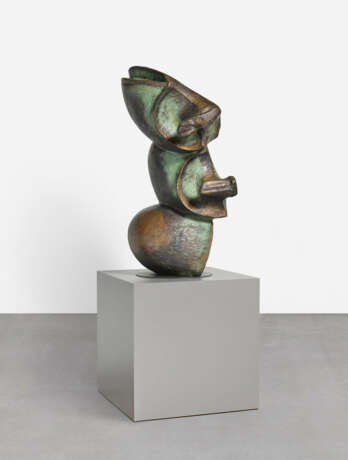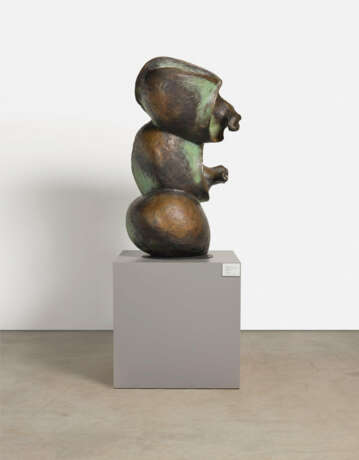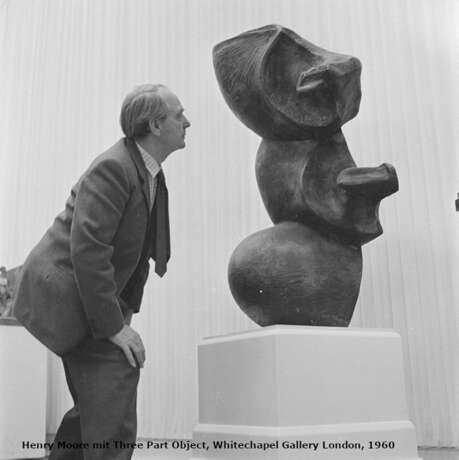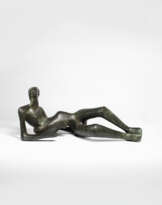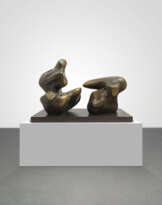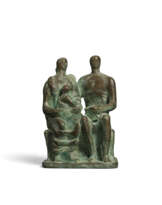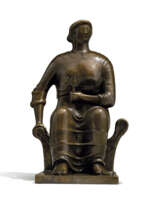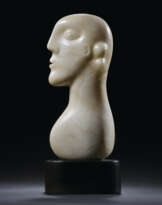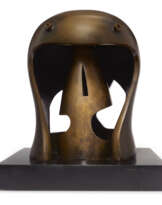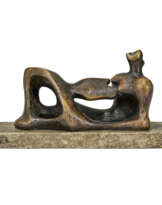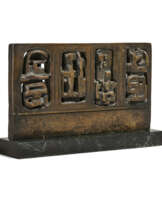ID 1406009
Lot 169 | Henry Moore. Three Part Object
Estimate value
€ 150 000 – 250 000
1898 Castleford/Yorkshire - 1986 Much Hadham
Title: Three Part Object.
Date: 1960.
Technique: Bronze, gold-brown patinized.
Measurement: 124 x 55 x 70cm.
Notation: Signed and numbered on the flat side, lower right: Moore 4/9.
Foundry Mark: Here also casting stamp GUSS H.NOACK BERLIN. Number: 4/9.
Frame/Pedestal: Base: 76 x 76 x 76cm (Total measurement: 200 x 76 x 76cm).
Provenance:
- Bayer Inc., USA
- Bayer AG, Leverkusen (acquired from the previous owner in 2005)
Exhibitions:
- Martin-Gropius-Bau, Berlin 2013
Literature:
- Mitchinson, David (ed.): Henry Moore - Plastiken, 1912-1980, Stuttgart 1981, cat. rais. no. 322, fig.
- Melville, Robert: Henry Moore - Skulpturen und Zeichnungen 1921-1969, Munich 1971, cat. rais. no. 603, fig.
- Exhib. cat. From Beckmann to Warhol, Art of the 20th and 21st Centuries - The Bayer Collection, Martin-Gropius-Bau, Cologne 2013, p. 184, fig.
- Museum piece by the most important English sculptor of the 20th century
- Organic bronze with universal expressiveness
- Exemplary sculpture of classical modernism with timeless appeal
Ein Klassiker der Modernen Skulptur
"Three Part Object" ist ein Spätwerk des englischen Bildhauers Henry Moore, in dem er seine bahnbrechenden Erfindungen der 1920-er und 1930er-Jahre gebündelt und durch den "klärenden Filter der Abstraktion" mit besonderer Kraft zum Ausdruck kommen lässt. (Holsten, Sigmar: Von Rodin bis Giacometti. Ausst.-Kat. Staatliche Kunsthalle Karlsruhe, 2009, S. 267) Moore ist der wohl wichtigste englische Bildhauer des 20. Jahrhunderts, und seine Werke haben auch heute nichts von ihrer universellen Wirkungsmacht eingebüßt. Mit seiner neuen, organischen Konzeption der Figur prägte er mehrere Generationen jüngerer Künstler*innen auf der ganzen Welt. Moores Stil wurde von Herbert Read als "Vitalismus" charakterisiert, der sich auf natürliche Formen als Motive seiner Bildhauerei konzentrierte. Tierknochen, Äste, Kieselsteine waren für ihn anregende Inspirationsquellen und stimulierten sein Interesse an Formen, Massen und Oberflächen. "Three Part Object" wurde aus drei unterschiedlichen Knochenformen entwickelt, erzeugt insgesamt gesehen dabei den Eindruck einer nahezu menschlichen Figur. In der Kunst begeisterte er sich für die Werke der antiken Hochkulturen Mesopotamiens, die Kunst der Maya und Azteken sowie die Skulpturen aus Ozeanien und Afrika, die er bei zahllosen Besuchen im British Museum eingehend studierte. "Für mich muss ein Werk in erster Linie eine eigene Vitalität haben," schrieb er 1934. "Damit meine ich nicht eine Spiegelung der Vitalität des Lebens, von Bewegung, physischer Aktion, von springenden oder tanzenden Figuren und so weiter, sondern dass ein Werk es in Form angestauter Energie, einer intensiven eigenen Lebendigkeit in sich trägt, unabhängig von dem Gegenstand, den es darstellen mag. Wenn ein Werk diese kraftvolle Vitalität besitzt, hat es auch nichts mit dem Wort 'Schönheit' zu tun. Es gibt einen Unterschied zwischen Schönheit des Ausdrucks und Ausdruckskraft. Die erste appelliert an sinnliche Freude, die zweite birgt eine spirituelle Vitalität, die mich stärker berührt und tiefer geht als bloße Sinnlichkeit". (Henry Moore, zit. nach Read, Herbert: Modern Sculpture. A Concise History, London 1989 (1964), S. 163.)
Universelle Ausdruckskraft
"Three Part Object" verkörpert Moores Haltung. Die Skulptur wirkt organisch, ohne auf eine bestimmte Figur oder Herkunft zu verweisen. Ihre Gestaltung schöpft aus dem großen Reservoir universaler Formen, das Moore in seinem Atelier und in seinen vielen Skizzenbüchern sammelte. "Ein empfindsamer Betrachter von Skulpturen (.) muss auch lernen, Form einfach als Form zu spüren und nicht als Beschreibung oder Erinnerung", sagte Moore in einer Radiosendung der BBC 1937. (Ebd. S. 182) Seine Skulptur bietet eine hervorragende Möglichkeit, diese universale Betrachtung von Skulptur zu praktizieren. Der Kunsthistoriker Sigmar Holsten hat die Qualität von Moores späten Skulpturen und ihre Ableitung aus organischen Naturformen wie folgt beschrieben: "Deren organoiden Urformen gewann er Phantastisches ab und lies aus leblosen Gegenständen Keime lebendiger Gestalten werden. Immer tendieren diese abstrakten Metaphern bei Moore zum Menschlichen". (Holsten, Sigmar: Von Rodin bis Giacometti. Ausst.-Kat. Staatliche Kunsthalle Karlsruhe, 2009, S. 267)
"Three Part Object" ist heute noch genauso inspirierend wie zur Zeit seiner Entstehung vor 65 Jahren. Ein anderes Exemplar der Skulptur schenkte der Künstler 1978 der Sammlung der Tate Gallery in London.
Kay Heyemer.
| Artist: | Henry Moore (1898 - 1986) |
|---|---|
| Auction house category: | Post War Objects |
| Artist: | Henry Moore (1898 - 1986) |
|---|---|
| Auction house category: | Post War Objects |
| Address of auction |
VAN HAM Kunstauktionen GmbH Hitzelerstr. 2 50968 Köln Germany | ||||||||||||||
|---|---|---|---|---|---|---|---|---|---|---|---|---|---|---|---|
| Preview | |||||||||||||||
| Phone | +49 221 92586215 | ||||||||||||||
| Fax | +49 221 92 58 62 4 | ||||||||||||||
| Buyer Premium | 32% | ||||||||||||||
| Conditions of purchase | Conditions of purchase | ||||||||||||||
| Business hours | Business hours
|
